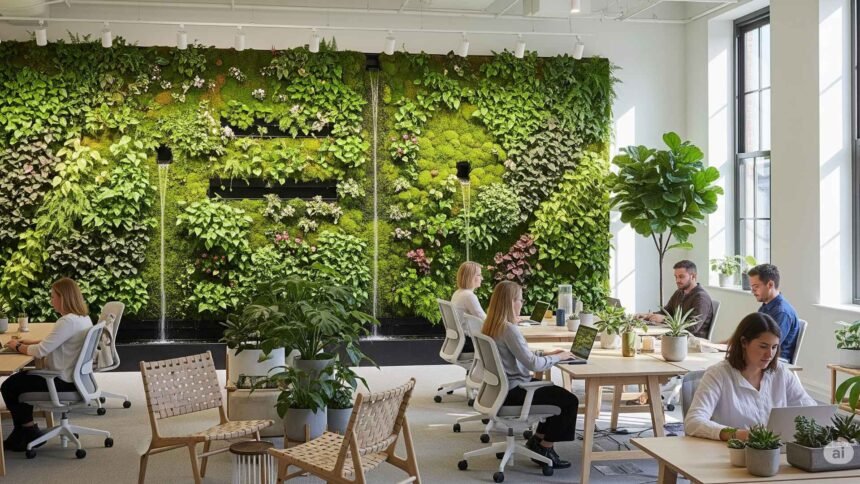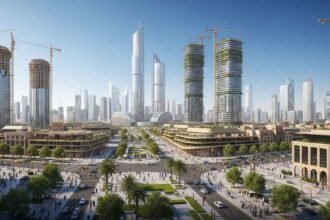As urban environments expand and people spend more time indoors—up to 90% of their lives, according to the EPA—there’s a growing need to reconnect with nature. Biophilic design addresses this by weaving natural elements into the built environment, fostering healthier and more productive spaces. A standout feature of this approach is the living wall, also known as a vertical garden or green wall, which brings lush greenery indoors.
What is Biophilic Design?
Biophilic design is rooted in the concept of biophilia, which suggests humans have an innate connection to nature. First introduced by psychologist Erich Fromm and later popularized by biologist Edward O. Wilson, biophilia describes our natural affinity for living systems. Biophilic design applies this idea to architecture and interior design, incorporating elements like natural light, water features, and greenery to create spaces that feel alive and restorative.
The approach is guided by principles such as using natural materials, maximizing daylight, and integrating plants. Research from sources like Terrapin Bright Green’s 14 Patterns of Biophilic Design highlights that these elements can reduce stress, enhance creativity, and improve well-being. For example, a study by the University of Exeter found that biophilic elements in offices increased productivity by 15% and reduced sick days by 6%.
The Role of Living Walls in Biophilic Design
Living walls are vertical structures that support plant growth, often using modular cassettes or hydroponic systems. They can be installed indoors or outdoors and are a cornerstone of biophilic design. These walls maximize space by allowing plants to grow vertically, making them ideal for urban settings where floor space is limited.
Living walls offer multiple benefits:
- Air Quality Improvement: Plants filter pollutants and release oxygen, enhancing indoor air quality. A study from Wageningen University noted that green walls can increase humidity by 5-17%, creating a healthier environment.
- Stress Reduction: Exposure to greenery has a calming effect, reducing stress and anxiety. Research shows that green walls can make people feel 71% healthier and 65% more energetic.
- Acoustic Benefits: Plants absorb sound, creating quieter spaces, which is particularly valuable in busy offices or public areas.
- Thermal Insulation: Living walls act as natural insulation, reducing energy costs by keeping spaces cooler in summer and warmer in winter.
- Aesthetic Value: They transform dull interiors into vibrant, inviting spaces, enhancing the visual appeal of any environment.
These benefits make living walls a practical and impactful way to bring biophilic design to life.
Case Studies: Living Walls in Action
Living walls are being implemented in diverse settings, showcasing their versatility and impact. Here are some notable examples:
| Project | Location | Description | Impact |
| Bosco Verticale | Milan, Italy | Two residential towers covered with over 900 trees, 5,000 shrubs, and 11,000 plants. | Mitigates smog, produces oxygen, and reduces energy costs through natural insulation (https://www.rmcad.edu/blog/biophilic-design-integrating-nature-into-modern-interiors/). |
| EQ Commercial Office | Bristol, UK | A 110 sqm living wall with 17 plant species reflecting the River Avon. | Enhances air quality and occupant well-being in a commercial setting (https://source.thenbs.com/manufacturer/biotecture-limited/gvKVTrJonnns9St7zWdRfg/case-studies). |
| Fosse Park Retail Center | Leicester, UK | Living walls installed as part of a £168m retail extension. | Creates an inviting shopping experience and supports sustainability goals. |
| Henry Ford Hospital | Michigan, USA | A living wall in the hospital atrium. | Reduces stress and creates a healing environment for patients and staff (https://www.terramai.com/blog/12-examples-innovative-living-walls/). |
| Bertschi School Science Wing | Seattle, USA | A living wall and greenhouse for hands-on learning. | Fosters environmental education and connects students with nature (https://living-future.org/biophilic-design/). |
These projects demonstrate how living walls can enhance aesthetics, functionality, and sustainability across residential, commercial, healthcare, and educational settings.
Health and Well-being Benefits
The health benefits of biophilic design and living walls are significant. Research published in the Journal of Environmental Psychology shows that workers in biophilic environments report higher job satisfaction and well-being. Exposure to nature can lower blood pressure, reduce stress hormones, and improve mood. In healthcare settings, studies suggest that views of nature can shorten hospital stays and reduce the need for pain medication.
Living walls specifically contribute to these benefits by improving air quality and creating a calming atmosphere. For instance, a virtual reality study found that green walls reduced stress levels and improved physiological responses like heart rate variability. These findings highlight the potential of living walls to create healthier indoor environments.
Economic and Market Trends
The demand for biophilic design is growing, driven by its health and environmental benefits. Properties with biophilic elements often command higher rental or sale prices due to their appeal and sustainability. For example, living walls can increase property value by enhancing aesthetics and supporting corporate social responsibility goals.
The market for living walls is expanding, with companies like Mobilane and Biotecture offering customizable solutions for various applications. Advances in technology, such as automated irrigation systems, are making living walls more efficient and easier to maintain, further fueling their popularity. As sustainability becomes a priority in construction, biophilic design is poised to play a central role in future projects.
Challenges and Considerations
While living walls offer numerous benefits, they come with challenges:
- Maintenance: Regular watering, fertilizing, and pruning are essential to keep plants healthy, which can be time-consuming and costly.
- Installation Costs: Initial costs vary depending on the system’s size and complexity, though long-term savings on energy and health costs can offset this.
- Technical Requirements: Proper irrigation and drainage systems are critical to prevent water damage. Plant selection must also suit local climate and light conditions.
These challenges can be mitigated with careful planning and professional installation. Companies specializing in living walls provide solutions to streamline maintenance and ensure long-term success.
Biophilic design, with living walls as a key feature, offers a powerful way to create healthier, more sustainable indoor environments. By bringing nature indoors, these designs improve air quality, reduce stress, and enhance productivity, all while adding beauty to spaces. From iconic projects like Bosco Verticale to local initiatives like the EQ office in Bristol, living walls are transforming how we live and work.
As the construction industry embraces sustainability and human-centric design, biophilic elements like living walls are becoming essential. For architects, developers, and building owners, these features offer an opportunity to create spaces that meet functional needs and nurture the human spirit. With proper planning, the benefits of biophilic design can far outweigh the challenges, paving the way for a greener, healthier future.







